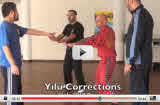Another exciting two hours today in Richmond Hill class. Two notes to share with audients:
- Actually using triangle to apply indirect power is not a new topic, but today our practice really impressed me. I started to understand how important it is and how to apply it to all forms.
- How to form a triangle: hold two hands together as point A and two elbows are the other two points (point B and point C). Partner tries to hold the two elbows tightly using his two hands.
- Practice one: push two elbows out against partner’s two hands. It is very hard.
- Practice two: focus on the point A. Push this point down, and do not think about the two elbows. Amazingly the two elbows are pushed outside and the partner’s hands are pushed away easily.
- Practice three: We also did a test during push hand. It did not work at the beginning as we did not lock the point B and point C. Another important thing is we also need to ensure the point B and point C are fully connected to point A. Otherwise the pushing power will be leaked during transmission.
- Conclusion one: the point A (two hands connected together) is just like our joint (such as shoulder joint, kua or knee). All we need to do is finding a triangle in our body, fix point B and C, and push point A.
- Conclusion two: The same triangle appears in our body everywhere. It may look different, but it acts exactly the same as what we experienced today.
- My mission: find those triangles in my body, and give it a try. I believe with more practice “Mission impossible” will become “Mission accomplished”.
2. Yilu correction by Kelvin Ho:
- Review form of “Right Golden Rooster Stands On One Leg”
- stretch left hand up and above head
- ensure left forearm is twisted
- keep body straight up. The back should also be straight. (My back was bending forward))
- keep left shoulder downward
- lift left leg
- right kua pops out to maintain the stable structure
- Correction on my “Step Back To Whirl Arms”
- my issue: moving leg and shoulder at the same time, and separation is not clear
- correction in detailed steps (use one as example): a)bring left hand close to face; b)bring right hand to left side; c)move right leg backward 45 degree, upper body does not move; d)shift weight to right leg and settle the leg e)bring right arm backward, ensure hand out; f)stretch both hands outward; g)bring left leg close to right leg
- I was not doing this form properly (i.e. central rod is un-clear, wrong position of both hands and back is not straight etc) , and Kelvin has spent quite time to correct me (very patient). Now I understood where my problem is, and it will be my next week’s focus.



